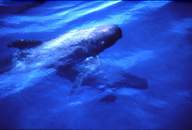|
European cattle: more than meets the eye? (june 2006)
Domestic animals are an important resource for economic development, and high genetic variability among them is essential, not only to maintain healthy populations, but also to allow improvement of the different breeds. European cattle have been thought to descend directly from a core of individuals domesticated in the Near East and which then spread throughout Europe what implied that in the continent all cattle were genetically very similar. But a new study, just published in the journal PNAS1, shows that cattle genetic composition in the continent, especially among the South European breeds, seems to be much more diverse than previously thought, and, consequently, can be an important source of biodiversity and economic potential.
Cattle domestication was one of the most important events behind the Neolithic agricultural revolution and it is believed to have started about 11,000 years ago. It led to changes, not only in alimentation, but also in human behaviour and affected the whole socioeconomic structure of society. Two major sites of cattle domestication are thought to have existed: the Indus valley (now Pakistan) where the taurine (Bos Taurus) cattle emerged, and the Fertile Crescent in the Near East where the zebu (Bos indicus) cattle appeared. These two groups resulted most probably from the domestication of two different types of the wild ancestral breed (Bos primigenius). A further domestication locus, this time in Africa, has also been proposed.
Based on the available genetic and archaeological evidence it was believed that European cattle was directly descendent from the domesticated group which emerged in the Near East and then, following the migration of the herbing and farming lifestyle, spread from the southeast to the north west. Surprisingly however, these data also supported the idea that European cattle never bred with the wild ancestral breeds (Bos primigenius) existent in Europe despite the fact that the two groups have coexisted for thousands of years in the continent, or with African domesticated cattle.
But now Albano Beja-Pereira and colleagues from several laboratories around Europe and Morocco have compared the mitochondrial DNA (mtDNA) from the remains of five Bos primigenius found in Italy and never studied before, with more than 1,000 individuals from both European and African modern breeds.
Mitochondrial DNA is found outside of the nucleus and, unlike the rest of the cell’s genetic material, is passed intact from mother to children. This is a big advantage for genetic studies as it serves as an “identity tag” marking continuous lines of descendants, which allows researchers to follow lineages for as far as millions of years.
The research now published found that the mtDNA from the five ancestral individuals was much more similar to modern continental European cattle, especially to Italian cattle, than to the breeds found in the Near East. This observation supports the view that there were several episodes of inter- breeding in the continent between the cattle originated in the Near East and local Bos primigenius. It was also found that South European cattle shared several sequences of their mtDNA with their counterparts in North African, sequences which were not found in the Near East specimens. This last result supports the idea of independent domestication episodes in Africa, and also seems to imply further genetic mixtures in European cattle, although this time only among the southern European breeds.
What is important about this study is the fact that shows that European cattle, especially in Southern Europe, is much more varied genetically than previously believed. Breeds introduced in Europe from those animals domesticated in the Near East seem to have mixed both with local wild animals but also with African cattle which probably entered the southern part of the European continent through the sea.
Cattle, like other livestock species, are important components of world biodiversity, especially because their genetic pool can be crucial to agriculture in the future. A high genetic diversity is crucial to prevent inbreeding and the loss of genes important for the maintenance of good quality specimens. In a time when the world population is steadily increasing, the genetic variability of South European cattle can be seen as an important source of genetic improvement for cattle around the world.

1 Proceedings of the National Academy of Sciences of the United states of America (2006); Vol (133), vol 21 pp. 8113-8118
“The origin of European cattle: Evidence from modern and ancient DNA”
Original paper’s author
|
In collaboration with the Observatório da Ciência e do Ensino Superior (OCES)
Financed by the Fundação para a Ciência e Tecnologia (FCT) |





